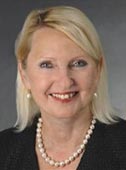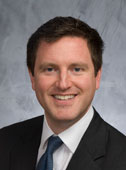Transplanting the Human Face
 Face transplant pioneer
Maria Siemionow
|
Should composite tissue grafts, such as face
transplants be performed in children?
Greg Borschel, recently recruited to the
Hospital for Sick Children (1) reviewed
the world experience with this dramatic
and complex intervention.
Thirteen face transplants have been
performed for problems such as facial
burns, dog bite, bear attack, neurofibromatosis
and gun shot wounds. He drew
attention to the challenges: as a small
donor pool, worse immunological challenges
when skin is transplanted, and
the surgical, psychological, rehabilitation,
patient selection and ethical issues.
Jennifer Flynn, philosopher in residence at HSC and a recent fellow at the
Joint Centre for Bioethics carefully laid out the ethical issues:
- The risk benefit ratio is a challenge because of medical uncertainty, the
finite life of the graft, and the probability that children may need a second
graft as their body matures;
- Informed consent is complexified in the paediatric population as parents or
other substitute decision makers will be held responsible for the outcome as
the child matures.
Consent of the donors also raises questions about potential morally dubious
motivation. Parents of a deceased child might "want to look at my child's face
in the future". Personal identity is closely linked to the face, and social adjustment,
especially in the teen years, will be predictably difficult.
Candidate selection must include careful evaluation of
the psychological health of the child following facial
trauma. She recommended that the surgical question
be referred to the Research Ethics Board in view of the
novelty and ethical complexity of the procedure. Finally,
the question arises of how badly off the patient will be
without a transplant, compared to the potential problems
and the prospect of a lifetime on imunosuppression.

Greg Borshel
|
Maria Siemionow who performed
the first successful
face transplant in the United
States was then introduced
by Ron Zucker. Maria used
the Mona Lisa to deconstruct
the importance of the
subunits of the face, the texture,
function, the identity,
the role of beauty, the range
of expression and the impact
of the face on social life.
The first challenge that her team faced was the technical
challenge, performing face and scalp transplants in
Lewis rats. These operations took approximately six and
one half hours. She learned that transplanting bone as
part of the composite graft brings in progenitor cells
which help survival of the graft as the animal becomes
a chimera. She added eye, ear and dental components
to the graft over a period of ten years and 1000 grafts.
The next phase was cadaver studies. She learned that
1192 square centimeters or 52x29 centimeters of skin
is needed to cover the human face. She and her colleagues
performed cadaver grafts six years before her
first human transplant.
The second challenge is the identity issue, much beloved
by the media. She worked with different models of a boy
and a man's facial bony structure and showed how different
the appearance of the same face becomes based on
the infrastructure. She and her colleagues studied identity
from various aspects. We are identified by our voice,
our walk and other characteristics in addition to the face,
though the face is the most prominent manifestation of
identity.
Before carrying out the first human face transplant,
she had done one thousand animal transplants, 40
cadaver studies and had 65 publications in top journals,
including bioethics journals. She wanted to be sure
that when she ventured into the experimental phase in
human patients that she "would not be perceived as a
Doctor Frankenstein." Based on her research alone, she
was twice voted by the Membership of the American
Association of Plastic Surgeons the winner of its highest
honour - The James Barrett Brown Award in 2004 and
again in 2007. The first human face transplant was not
performed until 2008.
Gaining approval from the Institutional Review Board/
Research Ethics Board was another challenge. The
Cleveland Clinic board comprised 40 members including
scientists, clinicians, lawyers and lay members. She
met with them weekly over a period of one year to secure
approval.
The next problem was gaining approval from organ
procurement organizations such as the Center for Organ
Recovery & Education (CORE), The Gift of Life
Program in Michigan and LifeBanc in Cleveland. This
required travel to the offices of these organizations and
presentations to convince their members took 4 years.
|
Patient selection was the next challenge. The importance
of this question is dramatically illustrated by the Chinese
patient who had suffered a bear attack. After he was
transplanted, he moved too far away from the transplant
centre to be rescued. When he deliberately stopped his
imunosuppression and switched to herbal medicine, he
lost the graft and eventually died. There have been two
deaths among the thirteen patients who have received
face transplants.
Maria's patient was a formerly beautiful woman who
suffered a gun shot wound to the face inflicted by her
husband. She had been healthy and stable with a tracheostomy
and feeding tube through 23 operations. The
cosmetic result of these interventions was unsatisfactory.
Other examples of the selection problems included a
burn patient who had no available back-up sites for skin
grafts if the transplant was rejected, and a cancer patient
whose cancer free status would remain questionable,
particularly on immunosuppression.
Complex theoretical issues of justification were explored.
Should older patents be excluded? In the hand transplant
experience of 50 patients, they proved to be poor adapters.
The cortical reorganization required was far more
successful in younger patients. Should blindness be a
contraindication? Patients who are blind cannot see signs
of rejection in the mirror. They need constant supervision
by another to be sure their medications are correctly
administered, and they cannot exercise their face while
looking in the mirror, as required for rehabilitation.
The fifth challenge is the team - an enormous interactive
group of psychologists, microsurgeons, ethicists, anesthiologists
and others. A total of 30 staff were required for
the 22 hour transplant operation. The cost of the procedure,
approximately $500,000, was somewhat lower than
the total cost of the 23 reconstructive procedures that
preceded it. Following transplantation, Maria's patient
underwent a period of rejection
which responded to
increased immunosuppresion.
She now has normal
two- point discrimination
and thermal sensation at 22
months. She can eat, smile
and phonate. The challenges
from the media were substantial.
Social reintegration
of the patient into family
and work is also a challenge.
There have been only two
women among the eleven
facial transplantations. The
social expectation of facial beauty in women is a biasing
factor.

Christopher Forrest
|
Her work was published last year in The Lancet (2).
Overall this 20 year tour de force of scientific and clinical
perseverance and humility was a thrilling experience
to learn about. It was heard by a packed auditorium and
given thunderous applause. She closed simply by saying
"you need a face to face the world".
In answer to a question from Christopher Forrest, Maria
told us that she is working in the laboratory to develop
an antibody which selectively blocks alpha-beta T cells
and spares gamma- delta T cells, which are tolerogenic.
This approach is now being tested in kidney transplant
patients. She is also fusing cells ex-vivo to make chimeric
cells for induction of tolerance in rats, and is attempting
to develop chimeric cells from human cord blood.
M.M.
1. See also The Surgical Spotlight, Spring, 2010
2. Maria Siemionow, Frank Papay, Daniel Alam, Steven
Bernard, Risal Djohan, Chad Gordon, Mark Hendrickson,
Robert Lohman, Bijan Eghtesad, Kathy Coffman, Eric
Kodish, Carmen Paradis, Robin Avery, John Fung. Neartotal
human face transplantation for a severely disfigured
patient in the USA. The Lancet, 2009, 374, 9685: 203 - 209
|
Maria Siemionow, MD, PhD, was awarded her
medical degree by the Poznan Medical Academy in
1974, after which she completed her residency in
orthopedics, and then earned a PhD in microsurgery.
In 1985, she completed a hand surgery fellowship
at the Christine Kleinert Institute for Hand
and Microsurgery in Louisville, Ky. Since 1995
she has been Director of Plastic Surgery Research,
and Head of Microsurgery Training in the Plastic
Surgery Department of Cleveland Clinic.
In 2005, she was awarded a faculty appointment as
Professor of Surgery in the Department of Surgery
at the Cleveland Clinic Lerner College of Medicine
of Case Western Reserve University. Most recently,
she received an honorary academic appointment as
Professor of Surgery at the Medical University in
Poznan, Poland.
Dr. Siemionow is the first U.S. physician to receive Institutional Review Board approval for facial transplantation surgery (Read more).
|
|